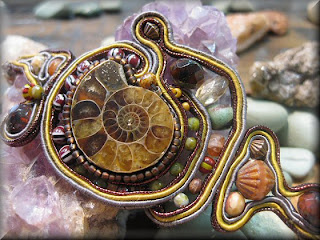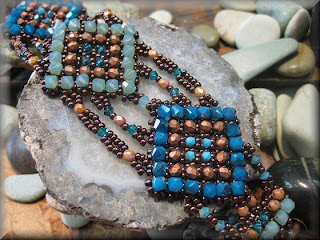Clasps are often the “forgotten design element” in a piece
of jewelry, but I'm here today to change that thinking!
While clasps serve a vital
function in jewelry, they are also an intrinsic part of a piece’s style, and
shouldn’t be overlooked as far as design goes. So, I’m going to spend a little
time talking about how clasps are much more than a mechanical device, about how
beautiful they can be, and how selecting the right claps really “completes” a
piece.
When we teach classes, one of our goals is to encourage
students to consider the clasp as more than just a fastener; that it is an
integral component in the overall design of the piece. Sometimes this means
using a traditional, simple lobster claw that disappears into the design of the
piece, sometimes the clasp should be a decorative component that flows
effortlessly in to the design and style of the piece, and sometimes it means
that the clasp serves as an eye-catching focal point that the entire piece is
designed around!

When selecting a clasp, the main things to think about are
the general style and scale of what you are trying to achieve: Are you
designing a very delicate necklace? Is it a chunky bracelet loaded up with all
sorts of colorful beads? Is it a finely detailed fabric of woven beads? These
are just a few possible questions you may want to ask yourself; needless to
say, just like the world of beads, the world of jewelry design is endless. These
sample questions give you a starting point of what you’ll want to consider when
selecting your clasp.
For example, if you’re creating a piece that is simple and
sleek, such as a single bead pendant that is dropping off a thin chain, then a small,
plain lobster claw is one of the best options for your clasp, because it will
disappear into the background, and not overpower the rest of the piece.

However, if your piece is comprised of heavier, chunkier
beads, then a decorative toggle clasp, box clasp, or s-hook would be a more suitable closure. In
these instances, the clasp becomes part of the design itself, and flows
seamlessly with the rest of the piece.

You wouldn’t want to use a simple
lobster claw here, because that natural flow of your beadwork would be interrupted; something
just wouldn’t seem “right”, visually. At the same time, while decorative, the clasp in this case
does not command the front-and-center spotlight.
Yet another great design option is using buttons as your clasp. Buttons work beautifully as closures on anything from wide beadeweaving projects to the popular wrap bracelets, and just about anything in between!
Using buttons for clasps really opens up a wide world, because they come in so very many styles, ranging from simple and understated to extremely elaborate; there are artisan buttons, glass buttons, clay buttons, manufactured buttons, antique buttons...the list goes on and on! Having so many options available makes it very easy to match a button to your piece.
But, there are times when the clasp itself IS the “wow”
point of the piece. These types of clasps are really exciting to work with, as
they provide you with a fresh new perspective on design! When the clasp is the
focal point, everything else included in the piece is selected accordingly.
And, when you look at such a piece of jewelry, you really don’t even see the
clasp; all you see is endlessly stunning beauty.
As you can see, there are lots of things to consider when
choosing a clasp. Clasps must be sturdy, strong, reliable, and funtctiona - but that doesn’t mean they
can’t be a gorgeous component of your piece as well!
The options avialable for clasps are virtually endless, so
be sure to put as much thought into the style of your clasp as you do in the
rest of your piece, and you will be thrilled with the results!
 Who doesn't love going from winter to spring? The promise of warmer weather and having the
sun out longer is definitely a reason to celebrate. But the change in weather doesn't happen
overnight despite the calender telling us that it is spring and we still tend
to wear boots and heavier coats well into April. Just because we can't wear our favorite peep
toes and short skirts just yet doesn't mean that our jewelry can't take the next
step into spring. Start making jewelry
now that reflects the bright colors of the season ahead. You may still be wearing your go to black
pants and gray sweaters but your jewelry can reflect the bright hues of
spring. Neon colors are huge for the warm season
this year so start by making a necklace or dangling earrings in a bright lime
green or black with coral accents. Just
the pop of bright color will be invigorating and exciting. Wear these new pieces with your winter
wardrobe to start your transition into your brighter clothes. The new jewelry you create will go perfectly
with your spring wardrobe.
Who doesn't love going from winter to spring? The promise of warmer weather and having the
sun out longer is definitely a reason to celebrate. But the change in weather doesn't happen
overnight despite the calender telling us that it is spring and we still tend
to wear boots and heavier coats well into April. Just because we can't wear our favorite peep
toes and short skirts just yet doesn't mean that our jewelry can't take the next
step into spring. Start making jewelry
now that reflects the bright colors of the season ahead. You may still be wearing your go to black
pants and gray sweaters but your jewelry can reflect the bright hues of
spring. Neon colors are huge for the warm season
this year so start by making a necklace or dangling earrings in a bright lime
green or black with coral accents. Just
the pop of bright color will be invigorating and exciting. Wear these new pieces with your winter
wardrobe to start your transition into your brighter clothes. The new jewelry you create will go perfectly
with your spring wardrobe.  Pantone named
Emerald Green the new color of 2013. This can
be worn as an accent jacket with black and white or as the focal in your
jewelry. Search for the perfect
centerpiece for a necklace in emerald or teal and finish the rest of the piece
with funky chain in bright brass or copper.
This will look great with chocolate brown right now, and will compliment
your white t-shirts and jeans come summer.
You may not be that excited to dig out your retro neon yellow fringe tee
from the 80's (if anyone actually kept any clothes from that decade) but adding
a hint of yellow to your jewelry in the form of chartreuse or jonquil gives a
nod to the current trends without sending you into a Flash Dance frenzy. After a long, cold winter we could all use
some brightness in our life and starting with your jewelry is definitely the
way to get rid of the winter blues.
Pantone named
Emerald Green the new color of 2013. This can
be worn as an accent jacket with black and white or as the focal in your
jewelry. Search for the perfect
centerpiece for a necklace in emerald or teal and finish the rest of the piece
with funky chain in bright brass or copper.
This will look great with chocolate brown right now, and will compliment
your white t-shirts and jeans come summer.
You may not be that excited to dig out your retro neon yellow fringe tee
from the 80's (if anyone actually kept any clothes from that decade) but adding
a hint of yellow to your jewelry in the form of chartreuse or jonquil gives a
nod to the current trends without sending you into a Flash Dance frenzy. After a long, cold winter we could all use
some brightness in our life and starting with your jewelry is definitely the
way to get rid of the winter blues.






















